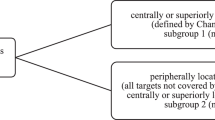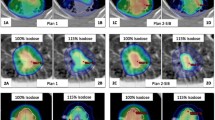Abstract
Purpose
The purpose of this study is to investigate the effect of plan complexity on the dosimetry, delivery accuracy, and interplay effect in lung stereotactic body radiation therapy (SBRT) using volumetric modulated arc therapy (VMAT) with 6 MV flattening-filter-free (FFF) beam.
Methods
Twenty patients with early stage non-small cell lung cancer were included. For each patient, high-complexity (HC) and low-complexity (LC) three-partial-arc VMAT plans were optimized by adjusting the normal tissue objectives and the maximum monitoring units (MUs) for a Varian TrueBeam linear accelerator (Varian Medical Systems, Palo Alto, CA, USA) using 6 MV FFF beam. The effect of plan complexity was comprehensively evaluated in three aspects: (1) The dosimetric parameters, including CI, D2cm, R50, and dose–volume parameters of organs at risk were compared. (2) The delivery accuracy was assessed by pretreatment quality assurance for two groups of plans. (3) The motion-induced dose deviation was evaluated based on point dose measurements near the tumor center by using a programmable phantom. The standard deviation (SD) and maximum dose difference of five measurements were used to quantify the interplay effect.
Results
The dosimetry of HC and LC plans were similar except the CI (1.003 ± 0.032 and 1.026 ± 0.043, p = 0.030) and Dmax to the spinal cord (10.6 ± 3.2 and 9.9 ± 3.0, p = 0.012). The gamma passing rates were significantly higher in LC plans for all arcs (p < 0.001). The SDs of HC and LC plans ranged from 0.5–16.6% and 0.03–2.9%, respectively, under the conditions of one-field, two-field, and three-field delivery for each plan with 0.5, 1, 2, and 3 cm motion amplitudes. The maximum dose differences of HC and LC plans were 34.5% and 9.1%, respectively.
Conclusion
For lung VMAT SBRT, LC plans have a higher delivery accuracy and a lower motion-induced dose deviation with similar dosimetry compared with HC plans.



Similar content being viewed by others
References
Rowell NP, Williams CJ (2001) Radical radiotherapy for stage I/II non-small cell lung cancer in patients not sufficiently fit for or declining surgery (medically inoperable): a systematic review. Thorax 56:628–638. https://doi.org/10.1136/thorax.56.8.628
Fakiris AJ, McGarry RC, Yiannoutsos CT et al (2009) Stereotactic body radiation therapy for early-stage non-small-cell lung carcinoma: four-year results of a prospective phase II study. Int J Radiat Oncol Biol Phys 75:677–682. https://doi.org/10.1016/j.ijrobp.2008.11.042
Nagata Y, Takayama K, Matsuo Y et al (2005) Clinical outcomes of a phase I/II study of 48 Gy of stereotactic body radiotherapy in 4 fractions for primary lung cancer using a stereotactic body frame. Int J Radiat Oncol Biol Phys 63:1427–1431. https://doi.org/10.1016/j.ijrobp.2005.05.034
Videtic GM, Paulus R, Singh AK et al (2019) Long-term follow-up on NRG oncology RTOG 0915 (NCCTG N0927): a randomized phase 2 study comparing 2 stereotactic body radiation therapy schedules for medically inoperable patients with stage I peripheral non-small cell lung cancer. Int J Radiat Oncol Biol Phys 103:1077–1084. https://doi.org/10.1016/j.ijrobp.2018.11.051
Li J, Galvin J, Harrison A et al (2012) Dosimetric verification using monte carlo calculations for tissue heterogeneity-corrected conformal treatment plans following RTOG 0813 dosimetric criteria for lung cancer stereotactic body radiotherapy. Int J Radiat Oncol Biol Phys 84:508–513. https://doi.org/10.1016/j.ijrobp.2011.12.005
Ball D, Mai GT, Vinod S et al (2019) Stereotactic ablative radiotherapy versus standard radiotherapy in stage 1 non-small-cell lung cancer (TROG 09.02 CHISEL): a phase 3, open-label, randomised controlled trial. Lancet Oncol 20:494–503. https://doi.org/10.1016/S1470-2045(18)30896-9
Ong CL, Dahele M, Slotman BJ et al (2013) Dosimetric impact of the interplay effect during stereotactic lung radiation therapy delivery using flattening filter-free beams and volumetric modulated arc therapy. Int J Radiat Oncol Biol Phys 86:743–748. https://doi.org/10.1016/j.ijrobp.2013.03.038
Hernandez V, Hansen CR, Widesott L et al (2020) What is plan quality in radiotherapy? The importance of evaluating dose metrics, complexity, and robustness of treatment plans. Radiother Oncol 153:26–33. https://doi.org/10.1016/j.radonc.2020.09.038
Zhang GG, Ku L, Dilling TJ et al (2011) Volumetric modulated arc planning for lung stereotactic body radiotherapy using conventional and unflattened photon beams: a dosimetric comparison with 3D technique. Radiat Oncol 6:152. https://doi.org/10.1186/1748-717X-6-152
Verbakel WF, van den Berg J, Slotman BJ et al (2013) Comparable cell survival between high dose rate flattening filter free and conventional dose rate irradiation. Acta Oncol 52:652–657. https://doi.org/10.3109/0284186X.2012.737021
Steenken C, Fleckenstein J, Kegel S et al (2015) Impact of flattening-filter-free radiation on the clonogenic survival of astrocytic cell lines. Strahlenther Onkol 191:590–596. https://doi.org/10.1007/s00066-015-0823-5
Baumann P, Nyman J, Lax I et al (2006) Factors important for efficacy of stereotactic body radiotherapy of medically inoperable stage I lung cancer. A retrospective analysis of patients treated in the Nordic countries. Acta Oncol 45:787–795. https://doi.org/10.1080/02841860600904862
Sadrollahi A, Nuesken F, Licht N, Rube C, Dzierma Y (2019) Monte-Carlo simulation of the Siemens Artiste linear accelerator flat 6 MV and flattening-filter-free 7 MV beam line. PLoS ONE 14:e210069. https://doi.org/10.1371/journal.pone.0210069
Masi L, Doro R, Favuzza V et al (2013) Impact of plan parameters on the dosimetric accuracy of volumetric modulated arc therapy. Med Phys 40:71718. https://doi.org/10.1118/1.4810969
Miften M, Olch A, Mihailidis D et al (2018) Tolerance limits and methodologies for IMRT measurement-based verification QA: recommendations of AAPM task group no. 218. Med Phys 45:e53–e83. https://doi.org/10.1002/mp.12810
Das IJ, Ding GX, Ahnesjo A (2008) Small fields: nonequilibrium radiation dosimetry. Med Phys 35:206–215. https://doi.org/10.1118/1.2815356
Vieillevigne L, Khamphan C, Saez J et al (2019) On the need for tuning the dosimetric leaf gap for stereotactic treatment plans in the Eclipse treatment planning system. J Appl Clin Med Phys 20:68–77. https://doi.org/10.1002/acm2.12656
Nguyen M, Chan GH (2020) Quantified VMAT plan complexity in relation to measurement-based quality assurance results. J Appl Clin Med Phys 21:132–140. https://doi.org/10.1002/acm2.13048
Ong CL, Verbakel WF, Cuijpers JP et al (2011) Dosimetric impact of interplay effect on RapidArc lung stereotactic treatment delivery. Int J Radiat Oncol Biol Phys 79:305–311. https://doi.org/10.1016/j.ijrobp.2010.02.059
Sande EPS, Acosta Roa AM, Hellebust TP (2020) Dose deviations induced by respiratory motion for radiotherapy of lung tumors: impact of CT reconstruction, plan complexity, and fraction size. J Appl Clin Med Phys 21:68–79. https://doi.org/10.1002/acm2.12847
Burton A, Offer K, Hardcastle N (2020) A robust VMAT delivery solution for single-fraction lung SABR utilizing FFF beams minimizing dosimetric compromise. J Appl Clin Med Phys 21:299–304. https://doi.org/10.1002/acm2.12919
Riley C, Yang Y, Li T et al (2014) Dosimetric evaluation of the interplay effect in respiratory-gated RapidArc radiation therapy. Med Phys 41:11715. https://doi.org/10.1118/1.4855956
Edvardsson A, Scherman J, Nilsson MP et al (2019) Breathing-motion induced interplay effects for stereotactic body radiotherapy of liver tumours using flattening-filter free volumetric modulated arc therapy. Phys Med Biol 64:25006. https://doi.org/10.1088/1361-6560/aaf5d9
Li G, Jiang W, Li Y et al (2021) Description and evaluation of a new volumetric-modulated arc therapy plan complexity metric. Med Dosim 46:188–194. https://doi.org/10.1016/j.meddos.2020.11.004
Fernandez DJ, Sick JT, Fontenot JD (2020) Interplay effects in highly modulated stereotactic body radiation therapy lung cases treated with volumetric modulated arc therapy. J Appl Clin Med Phys 21:58–69. https://doi.org/10.1002/acm2.13028
ICRU (2014) ICRU report 91: prescribing, recording, and reporting of stereotactic treatments with small photon beams. J Int Comm Radiat Units Meas 14(2):1–145
Low DA, Harms WB, Mutic S et al (1998) A technique for the quantitative evaluation of dose distributions. Med Phys 25:656–661. https://doi.org/10.1118/1.598248
Du W, Cho SH, Zhang X et al (2014) Quantification of beam complexity in intensity-modulated radiation therapy treatment plans. Med Phys 41:21716. https://doi.org/10.1118/1.4861821
Wang Y, Pang X, Feng L et al (2018) Correlation between gamma passing rate and complexity of IMRT plan due to MLC position errors. Phys Med 47:112–120. https://doi.org/10.1016/j.ejmp.2018.03.003
Rangel A, Dunscombe P (2009) Tolerances on MLC leaf position accuracy for IMRT delivery with a dynamic MLC. Med Phys 36:3304–3309. https://doi.org/10.1118/1.3134244
Jiang SB, Pope C, Al Jarrah KM et al (2003) An experimental investigation on intra-fractional organ motion effects in lung IMRT treatments. Phys Med Biol 48:1773–1784. https://doi.org/10.1088/0031-9155/48/12/307
Schwarz M, Cattaneo GM, Marrazzo L (2017) Geometrical and dosimetrical uncertainties in hypofractionated radiotherapy of the lung: a review. Phys Med 36:126–139. https://doi.org/10.1016/j.ejmp.2017.02.011
Bortfeld T, Jiang SB, Rietzel E (2004) Effects of motion on the total dose distribution. Semin Radiat Oncol 14:41–51. https://doi.org/10.1053/j.semradonc.2003.10.011
Bortfeld T, Jokivarsi K, Goitein M et al (2002) Effects of intra-fraction motion on IMRT dose delivery: statistical analysis and simulation. Phys Med Biol 47:2203–2220. https://doi.org/10.1088/0031-9155/47/13/302
Rao M, Wu J, Cao D et al (2012) Dosimetric impact of breathing motion in lung stereotactic body radiotherapy treatment using intensity modulated radiotherapy and volumetric modulated arc therapy. Int J Radiat Oncol Biol Phys 83:e251–e256. https://doi.org/10.1016/j.ijrobp.2011.12.001
Keall PJ, Mageras GS, Balter JM et al (2006) The management of respiratory motion in radiation oncology report of AAPM task group 76. Med Phys 33:3874–3900. https://doi.org/10.1118/1.2349696
Author information
Authors and Affiliations
Corresponding author
Ethics declarations
Conflict of interest
C. Ge, H. Wang, K. Chen, W. Sun, H. Li and Y. Shi declare that they have no competing interests.
Supplementary Information
Rights and permissions
About this article
Cite this article
Ge, C., Wang, H., Chen, K. et al. Effect of plan complexity on the dosimetry, delivery accuracy, and interplay effect in lung VMAT SBRT with 6 MV FFF beam. Strahlenther Onkol 198, 744–751 (2022). https://doi.org/10.1007/s00066-022-01940-3
Received:
Accepted:
Published:
Issue Date:
DOI: https://doi.org/10.1007/s00066-022-01940-3




